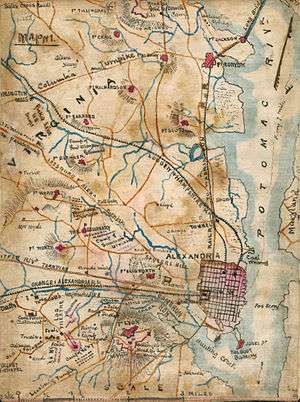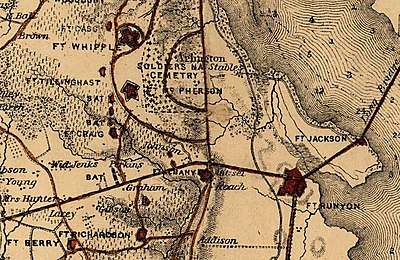Fort Albany (Arlington, Virginia)
Fort Albany was a bastioned earthwork that the Union Army built in Arlington County (known at the time as Alexandria County) in Virginia. The Army constructed the fort during May 1861 as part of its Civil War defenses of Washington (see Washington, D.C., in the American Civil War).[1]
| Fort Albany | |
|---|---|
| Arlington, Virginia | |
 Fort Albany | |
| Coordinates | 38.864917°N 77.066167°W |
| Site history | |
| Built | 1861 |


_(3361143083).jpg)
The fort had a perimeter of 429 yards and emplacements for 12 guns.[1] Fort Richardson, Fort Craig and Fort Tillinghast provided supporting fire for the fort.[1]
A May 17, 1864, report from the Union Army's Inspector of Artillery (see Union Army artillery organization) noted the following:
Fort Albany, Captain Rhodes commanding.–Garrison, one company First Massachusetts Volunteers–5 commissioned officers, 1 ordnance-sergeant, 145 men. Armament, two 24-pounder field howitzers, four 24-pounder siege, two Parrotts, one Coehorn mortar, one 10-inch mortar. Magazines, two; dry and in good order. Ammunition, full supply and in good condition. Implements, complete and in good order. Drill in artillery, fair. Drill in infantry, fair. Discipline, fair. Garrison of sufficient strength.[2]
No trace of the fort remains, although a historic marker shows the location where the fort once stood, guarding the approach to the Long Bridge along the Columbia Turnpike, near the modern-day Pentagon.[3] The ground on which the Fort stood was cut away during the construction of the Henry G. Shirley Memorial Highway, in 1942.[1]
Notes
- Cooling III, Benjamin Franklin; Owen II, Walton H. (2010). Defense Posts for the Long Bridge — Forts Albany, Runyan, and Jackson: Fort Albany. Mr. Lincoln's Forts: A Guide to the Civil War Defenses of Washington (New ed.). Scarecrow Press. pp. 90–92. ISBN 978-0-8108-6307-1. LCCN 2009018392. OCLC 665840182. Archived from the original on 2018-03-12. Retrieved 2018-03-05 – via Google Books.
- Howe, A.P., Brigadier-General, Inspector of Artillery (1864-05-17). Scott, Robert N. (ed.). Report on the inspection of the defenses of Washington, made by the order of the Secretary of War: Fort Albany, Captain Rhodes commanding. The War of the Rebellion: A Compilation of the Official Records of the Union and Confederate Armies. Published under the direction of the Secretary of War (1880-1891). Series 1 (Military Operations), Volume 36, Part 2, Chapter 48 (Operations in Southeastern Virginia and North Carolina). Washington, DC: United States Government Printing Office. p. 888. LCCN 03003452. OCLC 224137463. Retrieved 2018-03-15 – via HathiTrust Digital Library. (See: Official Records of the War of the Rebellion)
- Swain, Craig, ed. (2008-02-09). ""Fort Albany" marker". HMdb.org: The Historical Marker Database. Archived from the original on 2018-03-08. Retrieved 2018-03-05.
External links
Drawing of Fort Albany in the collection of the Library of Congress Retrieved 2018-03-14.